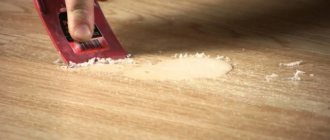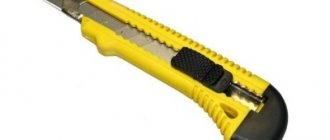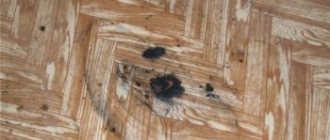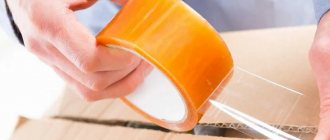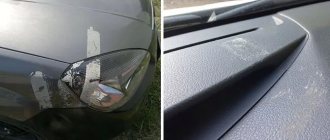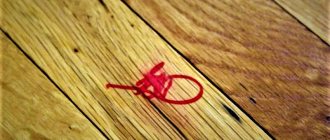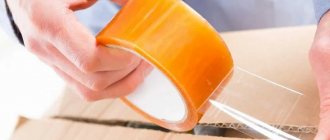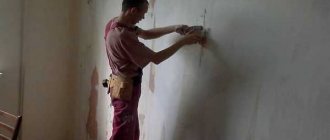I discovered the tape glued to the floor by accident; it must have been left over from a recent renovation, but I didn’t even notice. When the tape itself was removed, a wide line of glue remained on the floor - all of it remained on the surface. I had to remember how to wipe the tape off the linoleum. This must be done carefully: linoleum is a soft material, it melts easily, and the design on it is erased. I had to use several products in turn: baking soda, dish soap, laundry detergent. But I couldn’t remove the glue with a hairdryer: there wasn’t enough power.
Source ad-cd.net
Removing tape from furniture
Removing tape marks from a dresser
When transporting furniture, dismountable items are usually secured with adhesive tape, and very often buyers get confused trying to clean the adhesive. Here you can use the same products that are used when cleaning plastic, but you need to take into account a number of differences:
- Oil.
Using vegetable oil, adhesive stains are removed from any polished or painted surfaces, except for areas of untreated wood, since the oil will quickly absorb into it and leave greasy stains that cannot be removed. - White Spirit.
Thanks to a gasoline solvent, you can remove adhesive residues from any furniture surface, even from clean wood that is not protected by varnish or paint. In this case, it is extremely important to perform all actions as quickly as possible so that the product does not dissolve the polish itself. This rule also applies to the processing of painted products. - Eraser.
School erasers easily remove traces of adhesive tape from furniture, and you can preheat the dirty areas with a hairdryer. It is extremely important to be careful when removing glue so as not to damage the varnished surfaces while maintaining the attractive appearance of the furniture.
How to Remove Old Tape Marks
Scotch tape is like manna from heaven when you need to attach one thing to another, but trying to remove any remaining tape can be a real pain.
Removing tape residue can be easy or difficult depending on a number of factors, such as how long the tape has been in use and the type of surface it was applied to, but there are several remedies that can help deal with the problem.
Hair dryer in combination with other products
There are adhesive tapes that are insensitive to grease, water and household detergents. Residues can be removed using heat. They are heated with a household hairdryer and scraped off with a plastic spatula. You can also use a hair dryer, but then there is a risk that very hot air will melt or burn the surface.
You can also use an iron and heat the tape through the thick fabric. If these measures do not help and you cannot remove the tape, you must resort to chemical means. Add to the operation of the hair dryer the interaction of aggressive substances, such as:
- solvents,
- paraffin,
- turpentine,
- terpinol.
Before using them, test on a small area to ensure they do not damage the substrate.
Solvents are especially dangerous for plastics and coatings. They may melt or tarnish. They can also ruin the appearance of metal surfaces.
Remember to wear protective gloves, a mask and goggles when using chemicals to remove stuck tape, as they can cause irritation.
Unusual use of improvised solvents
Acetone can also be used to remove tape residue from wood. However, before using the solvent, it must be tested in an inconspicuous place.
- Dip a cotton swab in acetone.
- Rub the tape with a cotton swab until it is saturated with acetone.
- Leave for a few minutes.
- Wipe any remaining duct tape off the wood with a damp cloth. Repeat the process if the tape is still attached to the wood.
- Wipe the wood with a damp cloth and soapy water and dry with a towel. Don't let the acetone spend too much time on the wood, as it can damage the finish.
In some cases, you can also use white spirit. However, we recommend that you test on a hidden piece to ensure that the product will not discolour the surface.
Vegetable oil as an effective remedy for tape marks
Vegetable oil reduces the adhesion of the adhesive base of the tape to the surface. This is one of the gentlest, residue-free methods for removing tape without the use of harsh chemicals. This method is suitable for most types of wood.
Olive oil can only be used on surfaces that will not deteriorate or become soaked, so only on smooth wooden surfaces, not on delicate kitchen countertops or wooden furniture.
Steps to remove duct tape residue using vegetable oil:
- Pour vegetable oil onto a paper towel and spread it over the remaining tape.
- Leave to absorb for 30-40 minutes.
- Scrape or scrape away any remaining duct tape from the wood to remove as much of it as possible.
- Remove excess tape by lightly rubbing with a cotton pad.
- Wipe off remaining tape with a cloth soaked in soapy water.
- Wipe off the oil from the wood with a dry cloth.
There are other products that also work like baby oil, vegetable oil and mayonnaise. Be careful with absorbent materials such as carpets and clothing because the oil may stain.
Vinegar as an effective remedy for adhesive residue from tape
You can use mild acids such as white vinegar. They help a lot if the tape has been glued for a long time.
Make a compress using a soft cloth soaked in a solution of white vinegar and water and leave for a couple of seconds. Next, remove the softened tape, wash away any traces of vinegar and polish the surface with a clean, fresh cloth.
Removing tape from household appliances
Very often, people buy refrigerators, washing machines, microwave ovens and other types of household appliances, on which, after transportation, traces of adhesive tape from advertising stickers and adhesive pieces of protective film remain. Let us immediately note that reliable stores and household appliance showrooms usually offer customers special liquids or pencils, with the help of which the removal of adhesives is very quick and easy. If you are not offered them, you can use already known means:
- acetone;
- alcohol or vinegar;
- glass cleaner.
These substances are also excellent for removing adhesive stains from glass, mirrors, ceramic surfaces and tiles.
The most effective means for removing traces of tape from household appliances is nail polish remover, which is found in almost every handbag or cosmetic bag. Gas stove, glass, tiles - all this can be easily cleaned with this product. If, in addition to the adhesive, there are still pieces of film on the surface, you can moisten them with acetone for a few minutes, after which you can easily remove the remains with a napkin. The only drawback of this product is that it cannot be used on tinted glass and must be used with caution on metal surfaces.
To clean enamel appliances, you can use rubbing alcohol, vinegar, or glass cleaner. Many housewives use this method to remove glue residues, as well as the adhesive tape itself. To do this, you need to apply the product to the damaged areas of the surface of the devices, and then also wipe the equipment with a damp sponge or rag. The disadvantages of the method include the difficulty of removing old stains, but this disadvantage can be solved by heating the surface to be cleaned with a hairdryer for several minutes.
Cleaning plastic windows
Here you will need products that deal with stains on plastic and glass. In most cases, glasses are washed with household solvents, since they are not exposed to chemicals. Cleaning agents for plastic parts are chosen carefully, since many of them contain aggressive substances.
Glass cleaning liquid
This product quickly removes glue residue from windows. It is used for glass and plastic parts. Any liquid that contains ammonia will do. It is better to buy liquids sold in a convenient spray bottle. The liquid is sprayed onto the stain and wiped with a hard sponge. Then the remains are removed with a paper napkin. In addition to window cleaning liquid, car glass cleaner is also used in this way.
Acetone
This effective solvent will successfully remove stains from adhesive tape on the glass of a plastic window. To do this, soak a piece of cotton wool in the liquid and wipe the contaminated area with it. Use nail polish remover in the same way.
Important! Acetone can break down some types of plastic. It leaves dull spots on them. Therefore, the window frame is washed with caution.
Petrol
This liquid can dissolve the remaining adhesive layer from adhesive tape on plastic and glass. It is better to use already purified gasoline, which is used to refill lighters. Apply the product to a cotton pad and wipe the stained area with it. Then wash the traces of gasoline with soap and water.
Gasoline is a highly flammable substance. Therefore, be careful when working with it. After completing the cleansing, the room must be ventilated.
Another tape
This method is very simple. It is based on the fact that the old adhesive composition is combined with a new base. To remove a stain, perform the following steps:
- Cut a small piece of adhesive tape.
- Glue it over the old stain.
- They tear it off sharply.
- If the old residues are not completely removed, the procedure is repeated.
This method does not harm glass or plastic surfaces. Its effect can be supplemented by finally removing the stain with vegetable oil or white spirit.
Alcohol
To wipe off adhesive stains from the surface of plastic or glass, regular medical alcohol or alcohol-based solvents are suitable. Soak a rag in the liquid and wash off the stain. With this method, the old plastic becomes a little lighter, so it can also be used to remove yellowness.
Cleaning powder
You can remove adhesive tape residues from some plastic surfaces using a powder containing abrasive particles. The desired area is moistened and a cleaning agent is applied using a sponge. Then, use gentle movements to wipe away the dirt. If the plastic is soft, abrasive particles may leave scratches on it. Therefore, it is better to first test the effect of the powder on a small area.
Special means
In hardware stores you can find special pencils for removing glue residues. They will clean plastic, glass, ceramics, linoleum and other materials. To do this, just run a pencil over the stain and wipe off the residue with a rag.
In addition to pencils, there are liquid products on sale that remove remnants of tape and labels. They come in the form of a spray or liquid in a bottle. The product is sprayed onto the dirt or applied with a cotton swab. After a few minutes, wipe off the residue with a damp cloth.
There are many ways to get rid of sticky stains. Many of them are suitable for cleaning different materials. Therefore, choosing the most effective one will not be difficult.
Cleaning glass surfaces
Cleaning glass using white spirit
Glass
- This is a fairly stable material that allows it to be processed using chemicals and any other cleaning agents. Scotch tape can be easily removed from glass surfaces with vegetable oil, vinegar, alcohol, acetone or white spirit.
You can also easily clean the glass from double-sided tape, which has been “tightly” drying to the surface for a long time. To do this, you need to soak the adhesive layer by applying rag or cotton swabs, previously moistened with acetone or alcohol. After you hold the sponge for a few minutes, the glue is simply removed by simply wiping it with a napkin. You can also use the same hair dryer to soften the glue.
Competent linoleum repair (video)
When carrying out repair work, there is a high probability of contamination of the linoleum surface. It may lose its shine, streaks may remain on it, putty and primer may be spilled on it. After whitewashing, unsightly stains remain on the linoleum. Cleaning with soapy water or chemicals designed for working with linoleum will help give linoleum a beautiful appearance. It can be very easy to update linoleum if you know some tricks and techniques that can easily be found on the Internet on specialized sites.
Other cleaning products
People often need to clean linoleum or other surfaces from traces of tape. If it was not possible to remove the glue using improvised means (oil, eraser, alcohol, acetone), then in stores you can purchase professional products that are specifically designed for these purposes. There are also various cleaning liquids on the market, which are available in the assortment of many construction and automobile dealerships.
In addition, you can use a drill and a rubber nozzle. But this method is only effective for rough surfaces like metal, since soft parts can be easily damaged if you lack experience.
Scotch tape and eraser
This method is effective for removing glue residue from smooth and rough surfaces, but not from textiles. You can use a piece of the same adhesive tape that left sticky spots, or a different one. It is glued to the dirt and sharply torn off, pressed again, and torn off again, holding it between the tips of the fingers. It will take about 5 minutes to restore the shine to a plastic bottle.
A stationery eraser is also used to clean hard surfaces (wood, plastic, glass) from sticky dirt. The glue is rubbed off, working as if removing pencil marks from paper. The cleansing process is completed with a damp cloth.
Autobitumen
This product is sold in automobile stores. With its help, you can remove traces of adhesive tape from the coating. To do this, spray the can onto the dirt, wait two minutes until the composition is absorbed, then use a scraper to remove the glue. You will find out how it works by watching the video:
There are other methods that help remove dirty stains from the floor, but the ones we described above are still considered the best.
Average score of ratings is more than 0
Share link
Comments There are no comments yet, but you could be the first...
Bar of soap
When you encounter dirt, the first thing that comes to mind is to try washing it off with soap and water. Hot soapy water can easily remove fresh stains. Clothing and textile items are soaked and washed if this does not contradict the care instructions. A concentrated and hot soap solution can be used to remove adhesive tape from many surfaces, including metal and plastic. Dish gel is also used instead of soap.
Important! Like any liquid product, a soap solution can only be used on materials that are not contraindicated in contact with water.
Briefly about the main thing
Scotch tape can get on linoleum in different ways: it can be accidentally stuck by children, it can be echoes of repair or construction work. And although the tape is hardly noticeable, few people will like its presence on the floor.
The main problem is that when you remove the tape itself, a trace of glue remains on the surface. They are more difficult to remove: it is important not to use sharp metal objects or aggressive cleaning agents, as they easily deform the surface. It is better to choose less effective products that will not affect linoleum.
Question
Write in the comments if you ever had to scrub linoleum, and how well did it work?
Plant-based oils
A practical and convenient method using vegetable oil. There is always sunflower or corn oil, olive oil, grape seed oil, and aromatic essential oils in the house. Apply it with a sponge to the dirt and leave it for 10 minutes; it won’t hurt the process to forget about the item for a couple of days - the oil evaporates slightly and will dissolve the glue all this time. Then sticky stains are wiped off with a paper or cloth napkin, and oil stains are removed with soapy water.
The method is used for any non-absorbent surfaces. It is indispensable for cleaning plastic windows and polished furniture. It copes well with plastic surfaces and does not require any effort, unlike other methods.
Important! Oil cannot be used to clean textiles, wood, or veneer.
Alcohol-containing compounds
Sticky dirt from adhesive tape surrenders to medical alcohol, ammonia, and vodka. Compositions with ammonia (“Mr. Proper”, “Mr. Muscle”) are suitable for cleaning glass. The surface is cleaned with a cotton pad, which is generously moistened with the product. After waiting 3-5 minutes, remove the dirt with a dry cloth.
From surfaces covered with paint, it is impossible to wipe off stains from adhesive tape with alcohol- and acetone-containing products - they corrode the coating. These compositions are also not suitable for cleaning products made from colored polymers, but for a different reason: they bleach the coloring pigment of the plastic.
Advice! Before removing the adhesive from the adhesive tape, you should do a trial test on a small area. It will show whether the product can be used or whether it will ruin the item.
Solvents
Some of the most aggressive substances that can almost instantly remove tape marks are paint solvents and paint degreasers. Of course, they can melt plastic and ruin the paint - so they must be tested for safety, just like alcohol compounds.
White spirit, gasoline, acetone, and nail polish remover can be used to remove tape marks from clothing, furniture upholstery, and interior textiles. But, again, you need to clean things carefully so as not to discolor. Glass is not afraid of chemical attack, and the list of products for it, which already contains vegetable oil and alcohol compounds, can be supplemented with ordinary solvents and special chemicals.
Dry cleaning compounds
Powdered detergents will help clean the surfaces of household appliances and stoves from sticky adhesive tape.
Procedure:
- The cleaner is applied to a damp sponge and the dirt is wetted;
- give a few minutes to react;
- remove traces of glue using rubbing movements;
- remove dirt with a damp cloth;
- wipe dry.
Advice! Most cleaning powders are abrasive. They must be used selectively: not on any glass, metal or plastic, otherwise scratches will not be avoided.
Special household chemicals
In parallel with adhesive tapes, the production of special household chemicals for cleaning surfaces from adhesive tape has been launched.
"Anti-Scotch", professional cleaner
It is used like this:
- shake the spray can;
- spray on the problem area;
- after 2-3 minutes, lift the tape, pulling it over the edge and helping with a spatula;
- apply a spray for further clean removal of the tape.
The composition removes sticky traces of tape from any plastic and is also used for painted surfaces.
Mellerud, special cleaning spray
Suitable for any hard surfaces, including polymer ones. It is used by generously moistening a napkin and moistening the stained areas with it (for example, leaving the napkin lying on an old stain). After the solvent has worked, after 5-7 minutes, wipe the area with a damp cloth and then dry it. The composition is susceptible to contamination even from double-sided tape.
Cleaner Scotch-Weld, all-purpose cleaner
Use it to moisten a napkin and wipe off sticky traces of tape. The product is highly effective and safe when working with plastic. Profoam 2000 is used to remove stains from linoleum, polymers, and upholstery fabrics.
How to remove super glue from linoleum?
When working with super glue, you need to be very careful and prematurely protect the floor covering from the solution getting onto the surface. If, nevertheless, this trouble occurs, all that remains is to use chemicals.
In construction shopping centers you can buy special products for removing glue from the surface, but we will consider the option of how to remove glue from linoleum without purchased products.
One of the most effective means is purified gasoline. A similar method should be applied to the dried adhesive surface. You need to wait until the gasoline dissolves the adhesive mass, then wipe it with a dry cloth. If you don’t succeed in removing the glue the first time, you can repeat the same procedure several more times until it disappears completely.
Important! When working with this substance, you need to be very careful. It is advisable that there are no children in the room. Be sure to rinse with water after the procedure and ventilate the room.
